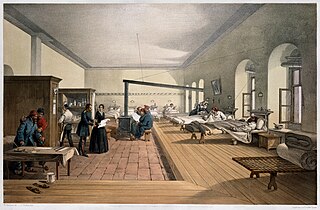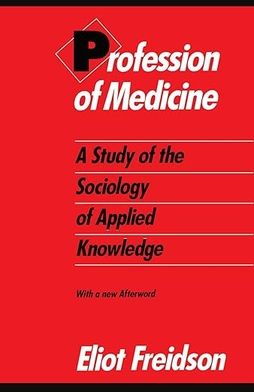Related Research Articles

A profession is a field of work that has been successfully professionalized. It can be defined as a disciplined group of individuals, professionals, who adhere to ethical standards and who hold themselves out as, and are accepted by the public as possessing special knowledge and skills in a widely recognised body of learning derived from research, education and training at a high level, and who are prepared to apply this knowledge and exercise these skills in the interest of others.
Social work is an academic discipline and practice-based profession concerned with meeting the basic needs of individuals, families, groups, communities, and society as a whole to enhance their individual and collective well-being. Social work practice draws from areas such as psychology, sociology, health, political science, community development, law, and economics to engage with systems and policies, conduct assessments, develop interventions, and enhance social functioning and responsibility. The ultimate goals of social work include the improvement of people's lives, alleviation of biopsychosocial concerns, empowerment of individuals and communities, and the achievement of social justice.
Ethical codes are adopted by organizations to assist members in understanding the difference between right and wrong and in applying that understanding to their decisions. An ethical code generally implies documents at three levels: codes of business ethics, codes of conduct for employees, and codes of professional practice.
Osteopathic medicine is a branch of the medical profession in the United States that promotes the practice of science-based medicine, often referred to in this context as allopathic medicine, with a set of philosophy and principles set by its earlier form, osteopathy. Osteopathic physicians (DOs) are graduates of American osteopathic medical colleges and are licensed to practice the full scope of medicine and surgery in all 50 US states. The field is distinct from osteopathic practices offered in nations outside of the U.S., whose practitioners are generally not considered part of core medical staff nor of medicine itself, but rather are alternative medicine practitioners. The other major branch of medicine in the United States is referred to by practitioners of osteopathic medicine as allopathic medicine.
Within the realm of communication studies, organizational communication is a field of study surrounding all areas of communication and information flow that contribute to the functioning of an organization. Organizational communication is constantly evolving and as a result, the scope of organizations included in this field of research have also shifted over time. Now both traditionally profitable companies, as well as NGO's and non-profit organizations, are points of interest for scholars focused on the field of organizational communication. Organizations are formed and sustained through continuous communication between members of the organization and both internal and external sub-groups who possess shared objectives for the organization. The flow of communication encompasses internal and external stakeholders and can be formal or informal.
A professional association is a group that usually seeks to further a particular profession, the interests of individuals and organisations engaged in that profession, and the public interest. In the United States, such an association is typically a nonprofit business league for tax purposes. In the UK, they may take a variety of legal forms.

Credibility comprises the objective and subjective components of the believability of a source or message. Credibility dates back to Aristotle theory of Rhetoric. Aristotle defines rhetoric as the ability to see what is possibly persuasive in every situation. He divided the means of persuasion into three categories, namely Ethos, Pathos, and Logos, which he believed have the capacity to influence the receiver of a message. According to Aristotle, the term "Ethos" deals with the character of the speaker. The intent of the speaker is to appear credible. In fact, the speaker's ethos is a rhetorical strategy employed by an orator whose purpose is to "inspire trust in his audience." Credibility has two key components: trustworthiness and expertise, which both have objective and subjective components. Trustworthiness is based more on subjective factors, but can include objective measurements such as established reliability. Expertise can be similarly subjectively perceived, but also includes relatively objective characteristics of the source or message. Secondary components of credibility include source dynamism (charisma) and physical attractiveness.
The norm of reciprocity requires that people repay in kind what others have done for them. It can be understood as the expectation that people will respond to each other by returning benefits for benefits, and with either indifference or hostility to harms. The social norm of reciprocity may take different forms in different areas of social life, or in different societies. This is distinct from related ideas such as gratitude, the Golden Rule, or mutual goodwill. See reciprocity for an analysis of the concepts involved.
Social position is the position of an individual in a given society and culture. A given position may belong to many individuals.
Professionalization or professionalisation is a social process by which any trade or occupation transforms itself into a true "profession of the highest integrity and competence." The definition of what constitutes a profession is often contested. Professionalization tends to result in establishing acceptable qualifications, one or more professional associations to recommend best practice and to oversee the conduct of members of the profession, and some degree of demarcation of the qualified from unqualified amateurs. It is also likely to create "occupational closure", closing the profession to entry from outsiders, amateurs and the unqualified.
Case management is a managed care technique within the health care coverage system of the United States. It involves an integrated system that manages the delivery of comprehensive healthcare services for enrolled patients. Case managers are employed in almost every aspect of health care and these employ different approaches in the control of clinical actions.
Identity formation, also called identity development or identity construction, is a complex process in which humans develop a clear and unique view of themselves and of their identity.

Health administration, healthcare administration, healthcare management or hospital management is the field relating to leadership, management, and administration of public health systems, health care systems, hospitals, and hospital networks in all the primary, secondary, and tertiary sectors.
Board certification is the process by which a physician or other professional demonstrates a mastery of advanced knowledge and skills through written, oral, practical, or simulator-based testing.
Organizational identification (OI) is a term used in management studies and organizational psychology. The term refers to the propensity of a member of an organization to identify with that organization. OI has been distinguished from "affective organizational commitment". Measures of an individual's OI have been developed, based on questionnaires.
David R. Hekman is an associate professor of organizational leadership and information analytics at the University of Colorado at Boulder. Hekman's research focuses on improving organizational health, including the demographic pay gap and the demographic power gap. His work has been written about in The New York Times, The Washington Post, The Boston Globe, The Chicago Tribune, The Atlantic, and Forbes.
Perceived psychological contract violation (PPCV) is a construct that regards employees’ feelings of disappointment arising from their belief that their organization has broken its psychological contract of work-related promises, and is generally thought to be the organization's contribution to a negative reciprocity dynamic, as employees tend to perform more poorly to pay back PPCV.

Medical sociology is the sociological analysis of medical organizations and institutions; the production of knowledge and selection of methods, the actions and interactions of healthcare professionals, and the social or cultural effects of medical practice. The field commonly interacts with the sociology of knowledge, science and technology studies, and social epistemology. Medical sociologists are also interested in the qualitative experiences of patients, often working at the boundaries of public health, social work, demography and gerontology to explore phenomena at the intersection of the social and clinical sciences. Health disparities commonly relate to typical categories such as class and race. Objective sociological research findings quickly become a normative and political issue.
Eliot Freidson was a sociologist and medical sociologist who worked on the theory of professions. Charles Bosk says that Freidson was a founding figure in medical sociology who played a major role in the growth and legitimization of the subject. The American Sociological Society awards the Eliot Freidson Outstanding Publication Award for medical sociology every two years.

Profession of Medicine: A Study of the Sociology of Applied knowledge is a book by medical sociologist Eliot Freidson published in 1970. It received the Sorokin Award from the American Sociological Association for most outstanding contribution to scholarship and has been translated into four languages.
References
- ↑ Ashforth B. E., & Mael F. A. (1989). Social Identity Theory and the Organization. Academy of Management Review, 14, 20-39.
- ↑ Cheney G. (1983). On the various and changing meanings of organizational membership: A field study of organizational identification. Communication Monographs, 50, 342-362.
- ↑ Dutton J. E., Dukerich J. M., & Harquail C. V. (1994). Organizational Images and Member Identification. Administrative Science Quarterly, 39, 239-263.
- ↑ Pratt, M.G., (1998). To be or not to be: Central Questions in organizational identification. In Whetten D.A., & Godfrey P.C. (Eds.): Identity in Organizations: Building theory through conversation (pp.171- 207). Thousand Oaks, CA: Sage.
- 1 2 Goltz, Heather Honoré; Smith, Matthew Lee (2014-11-01). "Forming and Developing Your Professional Identity Easy as PI". Health Promotion Practice. 15 (6): 785–789. doi:10.1177/1524839914541279. ISSN 1524-8399. PMID 25015568. S2CID 206740294.
- ↑ Bamber, E.W. & Iyer, V.M. 2002. Big 5 auditors' professional and organizational identification: consistency or conflict? Auditing: A Journal of Practice and Theory
- ↑ Freidson, E. 2001. Professionalism: The third logic. Chicago: University of Chicago Press.
- ↑ Hoff, T. J. 1999. The social organization of physician-managers in a changing HMO. Work and Occupations, 26: 324 –351.
- ↑ Tomer, Gunjan; Mishra, Sushanta Kumar (2015-06-01). "Professional identity construction among software engineering students: A study in India". Information Technology & People. 29 (1). doi:10.1108/ITP-10-2013-0181. ISSN 0959-3845.
- 1 2 Nyström, Sofia (2009). "The Dynamics of Professional Identity Formation: Graduates' Transitions from Higher Education to Working Life". Vocations and Learning. 2 (1): 1–18. doi:10.1007/s12186-008-9014-1. ISSN 1874-785X. S2CID 143402240.
- ↑ Gouldner, A. W. 1957. "Cosmopolitans and locals: Toward an analysis of latent social roles I." Administrative Science Quarterly, 2: 281–306.
- ↑ Hekman, D.R., Steensma, H.K., Bigley, G.A., Hereford, J.F., (2009) “Effects of Organizational and Professional Identification on the Relationship Between Administrators’ Social Influence and Professional Employees' Adoption of New Work Behavior.” Journal of Applied Psychology.
- ↑ Hekman, D.R., Bigley, G.A., Steensma, H.K., Hereford, J.F., (2009) “Combined Effects of Organizational and Professional Identification on the Reciprocity Dynamic for Professional Employees.” Academy of Management Journal, Vol. 52, No. 3.